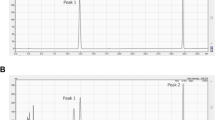Abstract
Cyclophosphamide (CP) administration to rats in a single i.p. dose (200 mg kg-1), while producing urinary bladder toxicity and 30-40% depression of the hepatic microsomal mixed function oxidase (MFO), failed to produce any depression of MFO activities in extrahepatic tissues such as lung, kidney and intestine. Phenobarbital pretreatment of the rats, which is known to enhance hepatic microsomal activation of CP, protected against CP-induced urinary bladder toxicity and the depression of hepatic MFO activities. This protection appears to be, at least in part, related to phenobarbital induction of hepatic cytochrome P-450 isozyme(s) that metabolizes CP to a new metabolite tentatively identified as didechlorodihydroxycyclophosphamide.
This is a preview of subscription content, access via your institution
Access options
Subscribe to this journal
Receive 24 print issues and online access
$259.00 per year
only $10.79 per issue
Buy this article
- Purchase on SpringerLink
- Instant access to full article PDF
Prices may be subject to local taxes which are calculated during checkout
Similar content being viewed by others
Rights and permissions
About this article
Cite this article
Gurtoo, H., Bansal, S., Pavelic, Z. et al. Effects of the induction of hepatic microsomal metabolism on the toxicity of cyclophosphamide. Br J Cancer 51, 67–75 (1985). https://doi.org/10.1038/bjc.1985.10
Issue date:
DOI: https://doi.org/10.1038/bjc.1985.10



